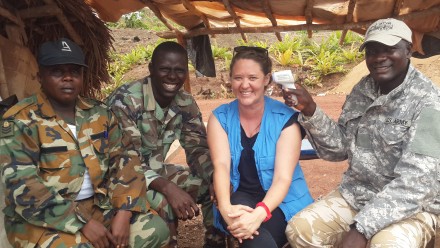Improving quality and sustainability in integrated PHC- Electronic Health Record Study
This report presents findings of a study titled “The use of an electronic health record (EHR) in a maternity shared-care environment”. The utility of the maternity EHR is compared with a paper hand-held record (PHR).
The PHR has been a successful and integral tool used in maternity shared-care for many years. Hamilton introduced the ‘Co-op (co-operation) card' in 1956 in the United Kingdom (UK) and since this time, women and clinicians have used some version of the PHR to record maternity care provided. The PHR continues to be widely used in the UK and also in Australia and New Zealand. The woman carries the PHR with her and the care given is documented at each visit to either the General Practitioner (GP) or the hospital health care provider. Evidence shows that PHRs improve communication between health care providers, reduce anxiety and increase women's involvement in their care.
The benefits of the PHR have been demonstrated in previous, mainly descriptive studies but little formal evaluation has been done on the data collected or on the experiences of health care providers using the PHR.
Increasingly, patient EHRs have been implemented around the world. These records are often driven by government regulations or financial institutions, predominantly in the USA, the UK and Denmark. EHRs have been designed to enhance integration and provide access to information in a digital format that can be used by both patients and health care providers, from anywhere at any time. Digital records are accessed using a variety of devices and media, including: USB (portable memory) stick and web-enabled interfaces of personal computers, smart phones or tablets.
Additionally, much work has been done on evaluating the implementation of EHRs in a variety of health care settings, such as hospitals, pharmacies, GP surgeries and allied health care providers (psychology, dietetics, social work and physiotherapy). Implementation issues of standardising processes, safety and security, promoting evidence based practice, ease of use, easing workload and using less paper charts have all been cited and continue to challenge using the EHRs to their full potential.
The EHR was proposed in Australia in the 2010/2011 federal budget and the Australian Government Department of Health and Aging (DoHA) with the National E-Health Transitory Authority (NEHTA) announced an investment over two years to deliver a national Personally Controlled EHR (PCEHR). The implementation of the EHR proposed to greatly enhance both the quality and the timeliness of available health care information. It was suggested that the PCEHR would allow consumers to have access to information, better manage their health care online and be beneficial to health care providers through improved sharing of clinical information. In wave two of the national EHR roll-out, the maternity EHR was introduced at the Mater Mothers’ Hospital (MMH), Brisbane, Queensland to operate in a GP shared-care environment. The initiative was aimed at addressing the fragmentation of care previously provided in the first National PHC Strategy “Towards a 21st Century Primary Health Care System”. The strategy identified that improvement was needed particularly in maternity care.
The maternity EHR was developed as an electronic alternative to the previously used paper based system, to be accessible to internal hospital health care providers, aligned GPs and participating women in a shared-care setting. The maternity EHR has incorporated access to the system for providers and women via doctor and patient portals.
Shared-care is seen as a service provided between the primary and secondary care sectors, with GPs as the fundamental component to providing a continuum for women centred care throughout their pregnancy. To improve the integration of care between these sectors, a clinical pathway was developed at the MMH, as a guide to define the roles both the GP and the hospital played in the management of the woman throughout her pregnancy. This pathway was added to the PHR as the antenatal visit schedule and checklist acting as a clinical prompt, delineating the activities to be conducted. The full pathway as seen in the PHR used at the MMH is provided in the report and is still today widely accepted as a clear guide to ‘best practice’ expectations of each provider at each antenatal visit. The pathway has streamlined antenatal care and provided a direct link between GP and hospital responsibilities, with an emphasis on creating partnerships with and making the woman the centre of her antenatal care.
The EHR in a maternity shared-care setting aims to further improve shared-care integration, in order to provide safe and effective clinical care between GPs, health care providers (midwives, doctors and allied health) and the woman herself. The success of the EHR relies heavily on web technologies and the incentive and time to participate in software designed to integrate shared-care information. There is evidence of using the PHR as an integration tool between shared-care health providers, but determining if the PHR or the EHR better facilitates this integration is not known. This study was undertaken to investigate the differences in using a PHR and an EHR in a GP maternity shared-care environment with regards to data completeness, experiences of users and integration of care between women and health care providers.
This report provides a summary of the study questions, study methods and results. It is supported by a systematic literature review published in January 2014 titled “In a maternity shared-care environment, what do we know about the paper hand-held and electronic health record: A systematic literature review”. The abstract for this paper is provided in Appendix 2. Three papers have also been submitted or are under review for publication. The first paper has been submitted to BMC Health Services Research and is a comparison of the completeness of clinical data in the paper hand held record (PHR) and the electronic health record (EHR), titled “Sharing of clinical data in a maternity setting: How do paper hand-held records and electronic health records compare?”. The second and third papers are descriptions of the experiences of the women and health care providers, using the PHR and EHR, which are currently in review and in progress (respectively).
Partnerships
- Glenda Hawley, RN (Nursing Prize), RM, Dip Nurse Management, Grad Dip Health Promotion, PhD Candidate, University of Queensland
- Professor Claire Jackson, University of Queensland
- Professor Julie Hepworth
- Dr Shelley Wilkinson, Nutritionist, Mater Mother’s Hospital







